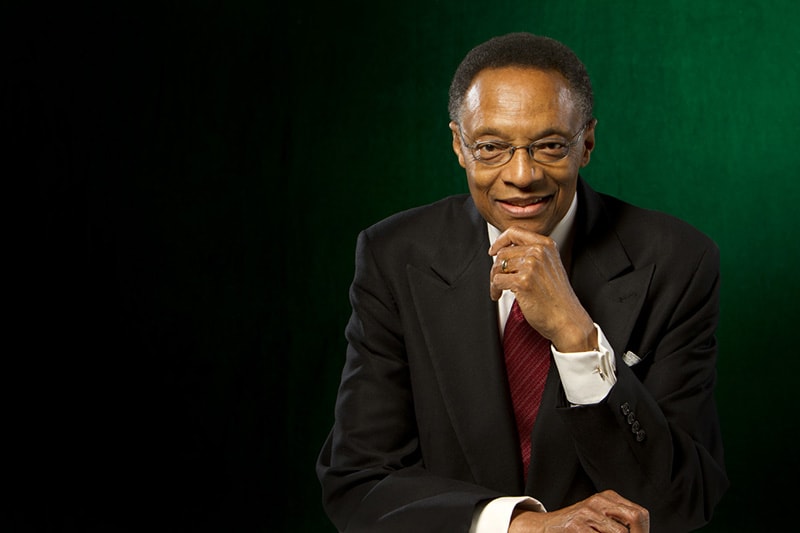Three Grammy Awards. 80 albums. Five gold records. A National Endowment for the Arts Jazz Master. Artistic director for the Ravinia Jazz Festival. Mentor for up-and-coming musicians through the Ravinia’s Mentor/Jazz Protégé program. Radio and television host. Recipient of an honorary doctorate from Loyola University Chicago. All of these accomplishments, and many more, are part and parcel of the long musical career of pianist Ramsey Lewis, who passed away this year on September 12.
Born in 1935, Ramsey Lewis was one of three children, first receiving piano lessons at age four. He had originally aspired to be a classical pianist, until he was directed towards jazz by his music teacher Dorothy Mendelson, who pointed out that a Black pianist’s ability to break into the classical world would be difficult. While attending Wells High School in Chicago, Lewis joined a group called the Clefs. With two of his classmates, Eldee Young (bass) and Red Holt (drums), he would form the Ramsey Lewis Trio in 1956, and would sign with Chess Records in 1957.
The original lineup of the Trio would break through with a Top 5 Billboard Hot 100 hit in 1965 – “The ‘In’ Crowd,” added at the last minute to a set list for the live recording (at the Bohemian Caverns) the album was based on.
Not charting quite as high, but still popular was the hit single “Wade in the Water.” After “The ‘In’ Crowd” became a hit, Young and Holt left the Trio and formed their own group, Young-Holt Unlimited. Taking their place was bassist Cleveland Eaton, and up-and-coming young drummer Maurice White. (The record jacket for the album Dancing in the Street foreshadows the future of the Trio’s new drummer when it says, “Because he has time on his side and an abundance of ambition and youthful vigor, Maurice White’s future promises to be a very hopeful one.” Indeed!)
As evidenced in his hit records, Lewis was forging a new path into what would later be called “soul jazz.” Many of his album tracks were cover versions of popular jazz recordings as well as pop and soul radio hits. When the Latin music craze hit the USA, Lewis put his own spin on the music with his trio, tapping into boogaloo which was a popular offshoot of Latin music. From the album Goin’ Latin, here is “One, Two, Three” with some hijinks from the occupant of the drummer’s seat.
Ever the melodic player, Lewis recognized and honored the melody of the Herbie Hancock song “Maiden Voyage,” and reframes it with his piano, strings, and vocal accompaniment. The album was produced by Charles Stepney.
Lewis’s trio would shift personnel over the years, but nowhere was the shift more evident when he signed with Columbia Records in 1972 and, in 1974, would hit Number 12 on Billboard’s Hot 100 with the soul-jazz song “Sun Goddess,” featuring labelmates and the band of his former drummer – Earth, Wind, & Fire.
That association would continue through his time with Columbia. From the album Salongo, which investigates African and Latin themes, the Maurice White and Martin Yarbrough song “Brazilica” would feature prominently in his repertoire for years to come. The album was produced by White and Charles Stepney, who also produced the earliest Earth, Wind & Fire albums until his untimely death.
Another song, the title track from the 1977 Tequila Mockingbird album, featured nearly the full Earth, Wind & Fire lineup except for Maurice White! His brothers Verdine (bass) and Fred (drums) play on the track, along with guitarist Johnny Graham, Philip Bailey (percussion), Al McKay (guitar), and Larry Dunn, who in addition to playing keyboards, penned and produced this track and two others.
Lewis would record for a handful of labels throughout his career, with his longest tenures signed to Chess, Columbia, and GRP. A pet project of Ramsey Lewis was his all-star jazz-funk collective Urban Knights, which would feature a shifting lineup with each album. The first two were produced by Maurice White and featured such jazz stars as Grover Washington, Jr., Freddie Hubbard, Jonathan Butler, Bill Meyers, Paulinho da Costa, Najee, Gerald Albright, a few of Earth, Wind & Fire’s current members (Sonny Emory, Sheldon Reynolds, Verdine White), and many others. In the spirit of giving back to the community, the third Urban Knights album featured primarily Chicago-area musicians and singers. From the first Urban Knights album, here is “On the Radio.”
Later in his career, Lewis began composing orchestral-themed songs and suites. He collaborated with the Joffrey Ballet and the Turtle Island String Quartet, and composed a concerto in celebration of his 80th birthday, which he debuted with the Chicago Symphony Orchestra. He was also tapped to compose “Proclamation of Hope,” an orchestral reflection on the life of Abraham Lincoln in honor of his bicentennial. While the 2009 album Songs from the Hart: Ramsey plays Ramsey doesn’t feature any of these performances, the recording finds Lewis and his trio in fine form performing a handful of these compositions, which are more complex than his earlier work yet still upbeat and accessible. The solo piano piece, “Clouds in Reverie,” shows a strong influence of Claude Debussy.
As the jazz landscape evolved over the decades, Ramsey Lewis was a constant presence. His musicality and adventurous spirit allowed him to visit many different musical styles and genres throughout his career, incorporating them into his sound, while continually retaining a strong identity that left no doubt to the listener that they were listening to a Ramsey Lewis record. Always tasteful and accessible, his music appealed to a wide audience who were not necessarily jazz fans. He will be missed, but we have several dozen recordings to remember him by. The music above is but a small sampling of what he had to offer us during his lengthy career.
Header image: Ramsey Lewis promotional photo, courtesy of RamseyLewis.com.





